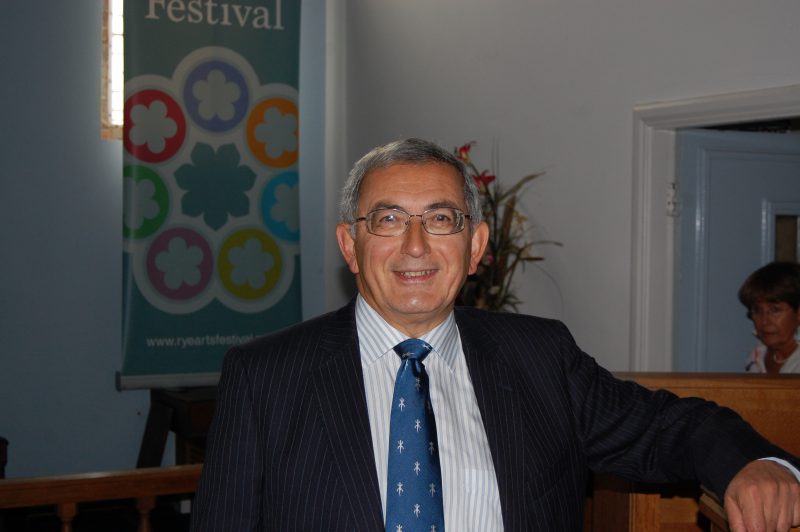In a three part series on the coronavirus outbreak Dr Andrew Bamji (pictured) writes first about the history of the outbreak to date and then in the two following parts he answers the most asked questions about the outbreak, updated to take into account any new developments.

Since I adapted my “Pandemic Polemic”, written about the swine flu epidemic, to fit this year’s coronavirus outbreak, a lot has changed. In Rye, the shops are shut and the streets relatively deserted; social distancing has been (largely) observed and many households have isolated themselves. Has it been worth it, or was my suggestion right that SARS-CoV-2 infection would for most be no more than a cold?
If you have been reading my blog (https://bamjiinrye.wordpress.com) and have started at the beginning you will see that I was partly right and partly wrong. Most people who are infected appear to have a mild illness, or none at all. However the virus is highly infectious and some people develop a severe illness, Covid-19, which results in lung failure and death.
The government has based its plans on “The Science”, but The Science thought originally that SARS-CoV-2 was a slightly nasty form of flu. But it’s very easy to see where things went wrong, and right, with hindsight. In medicine we call this the retrospectoscope, which is infallible. Dealing with something that is completely unknown is not easy. Watch “Chernobyl” on Sky or Amazon Prime to see an example of how an unforeseen technical issue can cause catastrophe.
“Science is not infallible”
Before I analyse what has happened so far I must point out again that science is not infallible. Back in the 1960s the professor of biochemistry at my medical school reminded each year group that the half-life of scientific knowledge was about six years. After which, he said, that means that half of what I have taught you will have been shown to be wrong. But we don’t know which half.
Scientific research is prey to many problems. There may be too many possible causes for something to be able to separate them out. Trials may be biased because inclusion criteria are skewed; thus, the trials of an anti-inflammatory drug, Opren, failed to detect a potentially fatal build-up of the drug in older people because the trials didn’t include older people.
Some trials fail to include dropouts in the analysis. The trial analysis may be faulty; the wrong statistical tests are applied. The tests used may be flawed; a lot of work was done in the 1970s looking at the glandular fever organism, the Epstein-Barr virus, as a cause of rheumatoid arthritis until it was shown that the positive results were due to a contaminated assay.
The trial may be too small; if a drug works a bit, you need a much larger trial population to prove it than if its effect is stupendous. Data analysis can be selective so the conclusion fits the hypothesis, as with fat and heart disease. Or there may be deliberate fraud, as with the investigation of a link between measles vaccination and autism. All of these factors conspire to change facts, let alone treatments in medicine.
“Stopping the NHS from being overwhelmed”
In the case of SARS-CoV-2 it was apparent at the beginning that people were dying from respiratory failure, and those with medium-term memory will recall that the initial measures put in place were to stop the National Health Service from being overwhelmed. This aim was achieved, even without recourse to the amazing construction of the Nightingale hospitals, which have admitted barely 40 patients instead of the thousands expected.
From an epidemiological viewpoint, isolation and prevention of transmission by social distancing were very important. They too have succeeded in limiting spread, though at a cost. But there were some mistakes.
Now we know how infectious the virus is, it was in retrospect a mistake to allow the Cheltenham race meeting to go ahead and a serious mistake to empty hospitals of care home residents without testing them before discharge.

I know that many people dispute the value of a lockdown; however, there is no doubt it limits infection, so I don’t. But it was always clear that releasing a lockdown would be problematic; people would go back to normal (not even new normal) and crowd beaches and demonstrations, and we have seen that in Rye.
“Government’s briefings … became formulaic and boring”
The government’s briefings were excellent to start with, but became formulaic and boring. We watched initially, but have given up. What facts were presented were presented well, but there were gaps and from a clinical viewpoint there was almost no explanation of what happened to people at the serious end of the disease, Covid-19.
All we got was BBC reporters making emotive visits to intensive care units. This is a pity, because it would have underlined the potential catastrophe for individuals who suffered it, but would also have highlighted the uncertainty of “The Science” – important, because the way deaths are reported daily give a sense of certainty. The total is provided with great precision, to six significant figures, but this does not guarantee accuracy.
The media has fuelled fear, of that I am in no doubt. Every decision has been questioned and criticised. Every plan has found its (often vocal) critics. As an example, when it was announced that testing would be “ramped up” to a daily capacity of 100,000 cold water was poured on the plan; it was impossible.
As the deadline drew nearer there was increasing excitement that the government would fail. Failure was not just expected, but would be greeted with glee. It didn’t fail.
Everything went very quiet until the media found something else they could tear to bits. It was not edifying; from a personal viewpoint I found it quite depressing, as I tried on several occasions to engage sensibly with journalists but had no reply, I suspect because my analysis did not fit with what they wanted to hear. Was my news fake, or was theirs?
Next week : So what questions might one ask, rather than repetitive and critical ones about testing and PPE?
Image Credits: Kenneth Bird , Carol Macdonald .



What an excellent article! – informative, balanced, entertaining – thank you so much, Dr Bamji and Rye News.
I very much agree with Bob Harper (Letter 12 June) – just what I wanted to write.
Thank you very much, Dr. Bamji and Rye News.
Thank you for this article. I have noticed that the public’s questions at the daily briefing have been to the point and more interesting than that of journalists. In pursuit of their ‘Gotcha’ headline journalists have displayed an appalling lack of professionalism. I think it is the media who will be the losers from the pandemic – I’m at the point that I just don’t believe them and turn the TV off the minute I detect a sneer or curled lip.
Excellent article, pleased to see your analysis of the destruction work by the press. I too attempted questions on numerous occasions without success. For one, I thought use of the nightingales for COVID 19 Patients would have freed general hospitals from terrified non COVID patients.
Staffing a Nightingale hospital with capacity for 1000 ventilated patients is impossible without withdrawing staff from existing hospitals, so while Susan O’Leary’s suggestion of separation is sensible it was, sadly, impractical – not least as the London version was supposed to have room for 4000. In any case, ventilation is not a good option, as I will be discussing in a later article.
Excellent article as always although I wasn’t aware that the 100,000 test target was achieved in the true sense of the claim ? I’d also like to read Andrew’s view on the reliability of testing, especially self-testing which I understand many medical professionals consider highly fallible
Like Susan O’Leary I too submitted questions without success. I still have not heard the answers – perhaps Andrew could enlighten me.
Firstly; Can the virus be destroyed on items placed in the freezer?
Secondly: With all the emphasis placed on hand washing, no mention was ever made about nails and the use of nail brushes. I know that I could wash my hands for any length of time but without the use of a nail brush my nails would still be dirty.
Simon Parsons raises an interesting question about testing. Part of the answer will appear in the next article but in summary a false positive test is rare. A negative is unhelpful (either for the antigen test – which is the one where a swab is put into the back of the nose and tells if you have it, or the antibody test, which is done on a blood sample and tells if you have had it). If the first is negative, it may mean you haven’t got it, you have had it and it’s gone, it’s coming but not far on enough to register or the test wasn’t done right. If the second is negative, either you haven’t had it, or it’s not far on enough to go positive, or it’s a false negative. A positive antigen test, therefore, is helpful, because even in the very rare case of a false positive the subject will isolate. A positive antibody test will reassure the subject they have had it, and are unlikely to be at risk. Thus an unreliable antibody test showing many false positives is dangerous because people may still be at risk but be wrongly reassured. That’s why there is such care taken to make sure that any widely used antibody test does not come up with false positives.
Hope that’s clear!
The answer to Antony Davis’ first question is no. There is not yet any direct evidence for SARS-CoV-2 but other coronaviruses have been shown to survive for up to two years in a freezer. There is a small possibility that the virus could hide under a dirty nail but it’s pretty small! Water and decent soap will dispose of most, even without a nailbrush.
Thank you Andrew